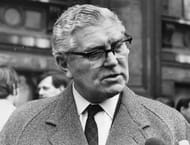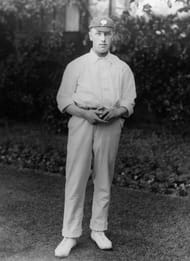
Modern cricketers crib about the unforgiving scheduling. Add the bio-bubble to their lives, and the miseries compound. But we are talking of a time when cricketers would be out on seven-month-long tours, playing non-stop. What if a team's priority lied in playing more series than they could? England had a solution.
In 1926, the West Indies and New Zealand were granted Test status. Two years later, West Indies toured England and made their Test debut. New Zealand still waited for the big moment.
The MCC (the then governing body of English cricket) were keen to send England to both the nations, but it wasn't be easy to squeeze out space in between the two Ashes series in Australia (1928-29 and 1932-33) and the South African tour (1930-31).
The 1929-30 season came as a rescue, and the MCC decided to send sides to both West Indies and New Zealand. It meant a lot to both the regions. Now three Tests old, West Indies were having visitors for the first time, and New Zealand were all set to debut.
West Indies were viewed as a more vigorous opposition, and therefore the more experienced men crossed the Atlantic. In contrast, a team with several newbies sailed to the other side of the world to face New Zealand.
England would traditionally visit New Zealand after the Ashes for a few non-international games.
This England team was far from the strong side the Kiwis had seen, but the idea of an English side touring their nation and not as an extended part of the Ashes tour brought them the sense of pride, as the recognition of being a Test-playing nation seeped in.
England's then captain Arthur Gillian opted out of both tours. Yet to play for England, Arthur's older brother and Sussex cricketer Harold Gillian was appointed England's captain for the New Zealand tour.
In another continent, in the Caribbean Isles, the elderly Englishmen were led by another debutant captain - the then 39-year-old Freddie Calthorpe.
England conquer debutants New Zealand
Seventeen debutants (all 11 from New Zealand and six from England) took the field at the AMI Stadium in Christchurch for the historic three-day Test.
New Zealand elected to bat first but were reduced to 15 for three, as debutant fast bowler Stan Nichols got the first three.
Sharing the new ball with Nichols was another fellow debutant, the Surrey medium-pacer Maurice Allom, who began his eight-over spell with a leg-before appeal against the English-born Kiwi all-rounder Roger Blunt, who managed a leg-bye.
Opener Stewie Dempster, who would later go on to establish himself as one of New Zealand's finest batters, was bowled off the next delivery. Two balls later, the Kiwi skipper Tom Lowry fell leg before. Ken James edged the next ball to the keeper, and the last ball of the over had Ted Badcock cleaned up.
The four wickets off five balls reduced New Zealand to 21 for seven.

Trivia: The hat-trick was watched by the former Australian off-spinner Hugh Trumble, then 62, from the stands. During his career, he had claimed two hat-tricks. Trumble was Australia’s most successful off-spinner until Nathan Lyon surpassed his tally in 2015.
Blunt’s 45 guided the struggling Kiwis to a three-figure score before they folded for 112. England ended the first day at 147 for four, with Duleepsinhji top-scoring with 49.
The second day of the Test was washed out. England managed 181 runs on the final day. Blunt, who had top-scored, claimed three wickets. New Zealand produced a better show in their second innings, managing 131 runs.
However, England came out attacking in their chase of 66 and completed a comfortable eight-wicket victory.
Brief scores:
New Zealand vs England, Christchurch – January 10-13, 1930
New Zealand 112 (Roger Blunt 45; Stan Nichols 4-28, Maurice Alom 5-38) & 131 (Tom Lowry 40; Maurice Allom 3-17) lost to England 181 (Duleepsinhji 49; Roger Blunt 3-17) & 66 for 2 (Duleepsinhji 33*; Roger Blunt 2-17).
England run into the Black Bradman
Meanwhile, on the other side of the earth, a stiffer challenge awaited England's senior pros. Quite literally the seniors: opener George Gunn, the Nottinghamshire legend, was 51. His opening partner Andy Sandham was relatively younger to him but was 39 - as old as the captain Calthorpe.
Nigel Haig, Ewart Astill and Ronald Stanyforth were 42, 41 and 38 respectively. There was also the legendary Yorkshireman Wilfred Rhodes. At 52, he was the oldest member of the squad and had debuted for England in the 19th century.
Despite a lot of persuasion from the West Indian administration, the legendary Jack Hobbs, then 47, was rested for the tour to have him fresh for the Ashes. Only five members in the side were under 30, including future stars Bill Voce and Les Ames.
The first Test that began on January 11 at Bridgetown marked two Englishmen's debuts (including their captain) and six West Indians. The debutants would include future legends – George Headley and Bill Voce.

Electing to bat first, West Indies rode on Clifford Roach’s hundred to pile up 369 runs. Leg-spinner Greville Stevens claimed a five-for. Sandham scored 152 to help England to a 98-run lead in the first innings.
Headley, 20, West Indies’ first great batsman and later nicknamed ‘the Black Bradman’, found his foot in international cricket in his very second innings. He slammed 176 before being dismissed by Rhodes, who was almost 33 years his senior!
From 304 for two, West Indies collapsed to 384, but the closely contested Test ended in a draw.
Brief scores:
West Indies vs England, Bridgetown, Barbados – January 11-16, 1930
West Indies 369 (Clifford Roach 122, Frank de Caires 80, Derek Sealy 58; Greville Stevens 5-105) & 384 (Clifford Roach 77, George Headley 176, Frank de Caires 70; Wilfred Rhodes 3-110, Greville Stevens 5-90) drew with England 467 (Andey Sandham 152, Patsy Hendren 80, Nigel Haig 47, Freddie Calthorpe 40; Learie Constantine 3-121) & 167-3 (Andy Sandham 51, Les Ames 44*).
Both the series were four-Test affairs. The fourth Test between England and New Zealand was played between February 21 and 24 at Eden Park, Auckland. During the same time, England and West Indies played the third Test of the series (February 21-26) at Georgetown.
It was the only other instance in cricket when a side played two Tests simultaneously.
Trivia: During the same time, in February, another English side - the Julien Cahn’s XI - began their voyage to Argentina for three First-Class matches.
Follow IPL Auction 2025 Live Updates, News & Biddings at Sportskeeda. Get the fastest updates on Mega-Auction and cricket news
